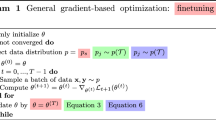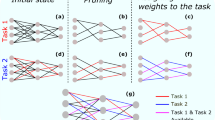Abstract
Deep Neural Networks (or DNNs) must constantly cope with distribution changes in the input data when the task of interest or the data collection protocol changes. Retraining a network from scratch to combat this issue poses a significant cost. Meta-learning aims to deliver an adaptive model that is sensitive to these underlying distribution changes, but requires many tasks during the meta-training process. In this paper, we propose a tAsk-auGmented actIve meta-LEarning (AGILE) method to efficiently adapt DNNs to new tasks by using a small number of training examples. AGILE combines a meta-learning algorithm with a novel task augmentation technique which we use to generate an initial adaptive model. It then uses Bayesian dropout uncertainty estimates to actively select the most difficult samples when updating the model to a new task. This allows AGILE to learn with fewer tasks and a few informative samples, achieving high performance with a limited dataset. We perform our experiments using the brain cell classification task and compare the results to a plain meta-learning model trained from scratch. We show that the proposed task-augmented meta-learning framework can learn to classify new cell types after a single gradient step with a limited number of training samples. We show that active learning with Bayesian uncertainty can further improve the performance when the number of training samples is extremely small. Using only 1% of the training data and a single update step, we achieved 90% accuracy on the new cell type classification task, a 50% points improvement over a state-of-the-art meta-learning algorithm.
Access this chapter
Tax calculation will be finalised at checkout
Purchases are for personal use only
Similar content being viewed by others
References
Andrychowicz, M., et al.: Learning to learn by gradient descent by gradient descent. In: Advances in Neural Information Processing Systems, pp. 3981–3989 (2016)
Ascoli, G.A., Donohue, D.E., Halavi, M.: Neuromorpho org: a central resource for neuronal morphologies. J. Neurosci. 27(35), 9247–9251 (2007)
Bengio, S., Bengio, Y., Cloutier, J., Gecsei, J.: On the optimization of a synaptic learning rule. In: Preprints Conference Optimality in Artificial and Biological Neural Networks, vol. 2. University of Texas (1992)
Bengio, Y.: Deep learning of representations for unsupervised and transfer learning. In: Proceedings of ICML Workshop on Unsupervised and Transfer Learning, pp. 17–36 (2012)
Bengio, Y., Bengio, S., Cloutier, J.: Learning a synaptic learning rule. Université de Montréal, Département d’informatique et de recherche \(ldots\) (1990)
De Jager, P.L., et al.: Alzheimer’s disease: early alterations in brain dna methylation at ANK1, BIN1, RHBDF2 and other LOCI. Nat. Neurosci. 17(9), 1156–1163 (2014)
Elizabeth, A., Weaver II, H.H.D.: Cells of the brain. https://www.dana.org/article/cells-of-the-brain/, August 2019
Fang, M., Li, Y., Cohn, T.: Learning how to active learn: A deep reinforcement learning approach. ar**v preprint ar**v:1708.02383 (2017)
Finn, C., Abbeel, P., Levine, S.: Model-agnostic meta-learning for fast adaptation of deep networks. In: Proceedings of the 34th International Conference on Machine Learning-Volume 70, pp. 1126–1135. JMLR.org (2017)
Gal, Y., Ghahramani, Z.: Dropout as a bayesian approximation: representing model uncertainty in deep learning. In: International Conference on Machine Learning, pp. 1050–1059 (2016)
Gal, Y., Islam, R., Ghahramani, Z.: Deep bayesian active learning with image data. In: Proceedings of the 34th International Conference on Machine Learning-Volume 70, pp. 1183–1192. JMLR.org (2017)
Goodfellow, I., et al.: Generative adversarial nets. In: Advances in Neural Information Processing Systems, pp. 2672–2680 (2014)
Gopalan, R., Li, R., Chellappa, R.: Domain adaptation for object recognition: an unsupervised approach. In: 2011 International Conference on Computer Vision, pp. 999–1006. IEEE (2011)
Hochreiter, S., Schmidhuber, J.: Long short-term memory. Neural Comput. 9(8), 1735–1780 (1997)
Hochreiter, S., Younger, A.S., Conwell, P.R.: Learning to learn using gradient descent. In: Dorffner, G., Bischof, H., Hornik, K. (eds.) ICANN 2001. LNCS, vol. 2130, pp. 87–94. Springer, Heidelberg (2001). https://doi.org/10.1007/3-540-44668-0_13
Joshi, A.J., Porikli, F., Papanikolopoulos, N.: Multi-class active learning for image classification. In: 2009 IEEE Conference on Computer Vision and Pattern Recognition, pp. 2372–2379. IEEE (2009)
Kingma, D.P., Mohamed, S., Rezende, D.J., Welling, M.: Semi-supervised learning with deep generative models. In: Advances in Neural Information Processing Systems, pp. 3581–3589 (2014)
Koch, G., Zemel, R., Salakhutdinov, R.: Siamese neural networks for one-shot image recognition. In: ICML deep learning workshop, vol. 2. Lille (2015)
Li, X., Guo, Y.: Adaptive active learning for image classification. In: Proceedings of the IEEE Conference on Computer Vision and Pattern Recognition, pp. 859–866 (2013)
MacKay, D.J.: Information-based objective functions for active data selection. Neural Comput. 4(4), 590–604 (1992)
McCallumzy, A.K., Nigamy, K.: Employing EM and pool-based active learning for text classification. In: Proceedings International Conference on Machine Learning (ICML), pp. 359–367. Citeseer (1998)
McKenzie, A.T., et al.: Brain cell type specific gene expression and co-expression network architectures. Sci. Rep. 8(1), 1–19 (2018)
Pan, S.J., Yang, Q.: A survey on transfer learning. IEEE Trans. Knowl. Data Eng. 22(10), 1345–1359 (2009)
Ravi, S., Larochelle, H.: Optimization as a model for few-shot learning (2016)
Saenko, K., Kulis, B., Fritz, M., Darrell, T.: Adapting visual category models to new domains. In: Daniilidis, K., Maragos, P., Paragios, N. (eds.) ECCV 2010. LNCS, vol. 6314, pp. 213–226. Springer, Heidelberg (2010). https://doi.org/10.1007/978-3-642-15561-1_16
Santoro, A., Bartunov, S., Botvinick, M., Wierstra, D., Lillicrap, T.: One-shot learning with memory-augmented neural networks. ar**v preprint ar**v:1605.06065 (2016)
Schweighofer, N., Doya, K.: Meta-learning in reinforcement learning. Neural Networks 16(1), 5–9 (2003)
Sener, O., Savarese, S.: Active learning for convolutional neural networks: a core-set approach. ar**v preprint ar**v:1708.00489 (2017)
Settles, B.: Active learning literature survey. University of Wisconsin-Madison Department of Computer Sciences, Technical report (2009)
Shorten, C., Khoshgoftaar, T.M.: A survey on image data augmentation for deep learning. J. Big Data 6(1), 60 (2019)
Skene, N.G., et al.: Genetic identification of brain cell types underlying schizophrenia. Nat. Genet. 50(6), 825–833 (2018)
Smith, L., Gal, Y.: Understanding measures of uncertainty for adversarial example detection. ar**v preprint ar**v:1803.08533 (2018)
Snell, J., Swersky, K., Zemel, R.: Prototypical networks for few-shot learning. In: Advances in Neural Information Processing Systems, pp. 4077–4087 (2017)
Vilalta, R., Drissi, Y.: A perspective view and survey of meta-learning. Artif. Intell. Rev. 18(2), 77–95 (2002)
Vinyals, O., Blundell, C., Lillicrap, T., Wierstra, D., et al.: Matching networks for one shot learning. In: Advances in Neural Information Processing Systems, pp. 3630–3638 (2016)
Woodward, M., Finn, C.: Active one-shot learning. ar**v preprint ar**v:1702.06559 (2017)
Zeng, H., Sanes, J.R.: Neuronal cell-type classification: challenges, opportunities and the path forward. Nat. Rev. Neurosci. 18(9), 530 (2017)
Zhu, X., Goldberg, A.B.: Introduction to semi-supervised learning. Synth. Lect. Artif. Intell. Mach. Learn. 3(1), 1–130 (2009)
Acknowledgments
This work was supported by the National Science Foundation (NSF-IIS 1910973), and the Intramural Research Program of the National Institute of Neurological Disorders and Stroke, National Institutes of Health (1R01NS109118-01A1).
Author information
Authors and Affiliations
Corresponding author
Editor information
Editors and Affiliations
Rights and permissions
Copyright information
© 2020 Springer Nature Switzerland AG
About this paper
Cite this paper
Yuan, P. et al. (2020). Few Is Enough: Task-Augmented Active Meta-learning for Brain Cell Classification. In: Martel, A.L., et al. Medical Image Computing and Computer Assisted Intervention – MICCAI 2020. MICCAI 2020. Lecture Notes in Computer Science(), vol 12261. Springer, Cham. https://doi.org/10.1007/978-3-030-59710-8_36
Download citation
DOI: https://doi.org/10.1007/978-3-030-59710-8_36
Published:
Publisher Name: Springer, Cham
Print ISBN: 978-3-030-59709-2
Online ISBN: 978-3-030-59710-8
eBook Packages: Computer ScienceComputer Science (R0)





